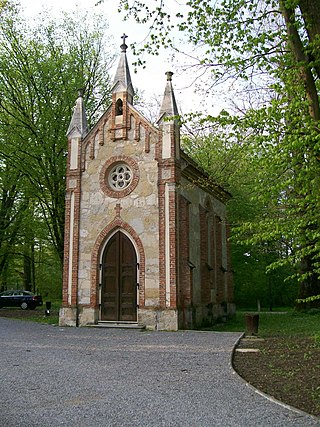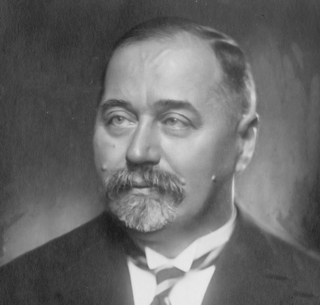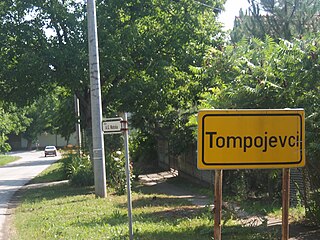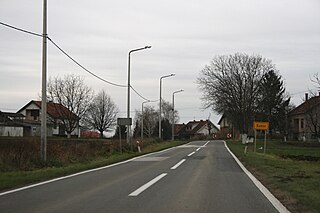
Jasenovac was a concentration and extermination camp established in the village of the same name by the authorities of the Independent State of Croatia (NDH) in occupied Yugoslavia during World War II. The concentration camp, one of the ten largest in Europe, was established and operated by the governing Ustaše regime, Europe's only Nazi collaborationist regime that operated its own extermination camps, for Serbs, Romani, Jews, and political dissidents. It quickly grew into the third largest concentration camp in Europe.

Zaprešić is a town in Hrvatsko zagorje, Zagreb County in Croatia. It has a population of 19,644 inhabitants in the town proper, with 25,223 in the administrative area. The town's metropolitan area, which encompasses the seven neighbouring municipalities, has a population of 54,640. Zaprešić is the third-largest, and most densely populated town of the county. It is located northwest of the Croatian capital Zagreb, and near the Slovenian border. It is centered on plains north of the Sava River, and is bordered by Medvednica Mountain to the east, and the Marija Gorica Hills to the west.

Stjepan Radić was a Croat politician and founder of the Croatian People's Peasant Party (HPSS), active in Austria-Hungary and the Kingdom of Serbs, Croats and Slovenes.

The Bleiburg repatriations were a series of forced repatriations from Allied-occupied Austria of Axis-affiliated individuals to Yugoslavia in May 1945 after the end of World War II in Europe. During World War II, Yugoslavian territory was either annexed or occupied by Axis forces, and as the war came to end, thousands of Axis soldiers and civilian collaborators fled Yugoslavia for Austria as the Yugoslav Army (JA) gradually retook control. When they reached Austria, in accordance with Allied policy, British forces refused to take them into custody and directed them to surrender to the JA instead. The JA subsequently subjected them to death marches back to Yugoslavia, where those who survived were either subject to summary executions or interned in labor camps, where many died due to harsh conditions. The repatriations are named for the Carinthian town of Bleiburg, where the initial British refusal to accept the surrenders occurred, and from which some repatriations were carried out.
Far-right politics in Croatia refers to any manifestation of far-right politics in the Republic of Croatia. Individuals and groups in Croatia that employ far-right politics are most often associated with the historical Ustaše movement, hence they have connections to Neo-Nazism and neo-fascism. That World War II political movement was an extremist organization at the time supported by the German Nazis and the Italian Fascists. The association with the Ustaše has been called "Neo-Ustashism" by Slavko Goldstein.
The Gospić massacre was the mass killing of 100–120 predominantly Serb civilians in Gospić, Croatia during the last two weeks of October 1991, during the Croatian War of Independence. The majority of the victims were ethnic Serbs arrested in Gospić and the nearby coastal town of Karlobag. Most of them were arrested on 16–17 October. Some of the detainees were taken to the Perušić barracks and executed in Lipova Glavica near the town, while others were shot in the Pazarište area of Gospić. The killings were ordered by the Secretary of Lika Crisis Headquarters, Tihomir Orešković, and the commander of the 118th Infantry Brigade of the Croatian National Guard, Lieutenant Colonel Mirko Norac.
The Vukovar massacre, also known as the Vukovar hospital massacre or the Ovčara massacre, was the killing of Croatian prisoners of war and civilians by Serb paramilitaries, to whom they had been turned over by the Yugoslav People's Army (JNA), at the Ovčara farm southeast of Vukovar on 20 November 1991, during the Croatian War of Independence. The massacre occurred shortly after Vukovar's capture by the JNA, Territorial Defence (TO), and paramilitaries from neighbouring Serbia. It was the largest massacre of the Croatian War of Independence.

Tompojevci is a village and municipality in the Vukovar-Syrmia County in Croatia.

The A2 motorway is a motorway in the Hrvatsko Zagorje region of northern Croatia, connecting Zagreb to the Macelj border crossing and Slovenia. The A2 motorway is part of the European route E59 and the Pan-European Corridor Xa. The motorway spans 59.2 kilometres (36.8 mi) between the Slovenian border and the Jankomir interchange within the Zagreb bypass, providing road connections to a number of cities and towns besides Zagreb, including Krapina, Zabok and Zaprešić. All sections of the motorway, except the northernmost one between the Macelj border crossing and Trakošćan, and the southernmost one near Zagreb, are tolled, using a closed toll collection system.
The Baćin massacre was the killing of 83 civilians just outside the village of Baćin, near Hrvatska Dubica, committed by Croatian Serb paramilitaries. The killings took place on 21 October 1991 during the Croatian War of Independence. Most of the civilians were Croats, but they also included two ethnic Serbs, taken from Hrvatska Dubica, Baćin and the nearby village of Cerovljani. The civilians were killed in the area of Krečane, at the very bank of the Una River, and their bodies were left unburied for two weeks. Most of them were subsequently bulldozed into a shallow mass grave, while a number of the bodies were thrown into the river. Further killings of Croat civilians continued in Baćin and surrounding areas until February 1992.
The Commission on Concealed Mass Graves in Slovenia is an office of the Slovenian government whose task is to find and document mass grave sites from the Second World War and the period immediately after it. It was established on November 10, 2005. The commission handed its report to the Slovenian government in October 2009.

The accession of Croatia to NATO took place in 2009. The country entered into Partnership for Peace in 2000, which began the process of accession into the alliance. It received an invitation to join at the 2008 Bucharest summit and became a full member on April 1, 2009.

Sotin is a village in eastern Croatia, located a few kilometers southeast of Vukovar by the Danube. It is administratively part of the city of Vukovar, and its population is 597. The post code for Sotin is 32232 Sotin.

The Church of the Holy Salvation or Holy Saviour was a Pre-Romanesque church in the Dalmatian Hinterland, Croatia, whose ruins are now a historic site. It is located in the small village of Cetina, near the spring of the river Cetina, 8 km northwest from the town of Vrlika.
The Erdut killings were a series of murders of 37 Hungarian and Croat civilians in the village of Erdut, Croatia committed by Croatian Serb forces and Serb Volunteer Guard paramilitaries between November 1991 and June 1992, during the Croatian War of Independence. Twenty-two Hungarians and 15 Croats were killed. The first killings occurred on 10 November 1991, when twelve civilians died. Eight more were killed over the following several days. Five more civilians were killed on 10 December, and another seven on 16 December. Four others were killed on 21 February 1992 and the final one was killed on 3 June. The bodies of these victims were either buried in mass graves or thrown into nearby wells.

Ćelije sometimes also referred to as Ćelija, is a village in eastern Croatia located west of Trpinja and south of the Osijek Airport. The population is 121.

Croatia–Holy See relations refer to the bilateral relationship between Croatia and the Holy See. Diplomatic relations among the two countries were established on February 8, 1992, following Croatia's independence from SFR Yugoslavia, although they date far back in history.
The Gračani massacre was the killing of several hundred prisoners of war of the Croatian Armed Forces and civilians in May 1945 in Gračani, a neighborhood of Zagreb, Croatia. The massacre was perpetrated by the Yugoslav Partisans after the end of World War II in Yugoslavia. As of September 2018, bodies of 295 victims were exhumed from the site.
Stjepan Razum is a Croatian church historian and Roman Catholic priest. He is the director of the Archdiocesan Archives in Zagreb and a member of the Commission for the Croat martyrology of the Episcopal Conference of Bosnia and Herzegovina and Episcopal Conference of Croatia; mainly researching on the Catholic priests and nuns killed and persecuted by Yugoslav communists.











